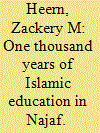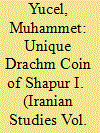|
|
|
Sort Order |
|
|
|
Items / Page
|
|
|
|
|
|
|
| Srl | Item |
| 1 |
ID:
152554


|
|
|
|
|
| Summary/Abstract |
The toponym Kerend has a long history. This study explores the appearance of Kerend in pre-modern sources, beginning with the toponym Karintaš in the late second millennium BC. Kassite, Elamite and Assyrian rivalry for control over the central western Zagros mountains is discussed and the survival of the name in later antiquity is investigated. A derivative of the name appears in Claudius Ptolemy’s Geography and in the Parthian Stations of Isidore of Charax, as well as in the late Antique Cosmographia of the Anonymous Geographer of Ravenna. A homonymous name from the area east of the Caspian Sea is also discussed, as are several unrelated names occurring in other sources (Achaemenid Elamite, Armenian).
|
|
|
|
|
|
|
|
|
|
|
|
|
|
|
|
| 2 |
ID:
152568


|
|
|
|
|
| Summary/Abstract |
Abstract
In January 1954, the Iranian émigré poet living in the Soviet Union, Abulqasim Lahuti, was summoned before the Central Committee in Moscow to discuss the publication of a fraudulent Persian-language autobiography that reflected unfavorably on his experiences in the Soviet Union. This autobiography was the result of a 1953 CIA operation in Iran launched by Donald Wilber after he had become convinced that in case of a Soviet takeover Lahuti would be the one most likely put forward as leader. To preempt this threat, the CIA published the counterfeit autobiography. Unlike Mosaddeq and other CIA targets, however, Lahuti’s position as a cultural mediator between the Soviet Union, Soviet Tajikistan, and Iran made the consequences of this operation more complex than the CIA had imagined. This paper explores its aftermath using recently declassified Soviet archival documents and interviews. It argues that this operation transformed Lahuti’s professional and social standing in Moscow, empowered him to challenge his long-time enemy Bobojon Ghafurov on the issue of Tajik ethnogenesis, and helped change the official Stalinist line on Persian literary culture. Lastly, this operation politicized Lahuti’s biography in ways that are relevant to the present day.
|
|
|
|
|
|
|
|
|
|
|
|
|
|
|
|
| 3 |
ID:
152564


|
|
|
|
|
| Summary/Abstract |
According to Shiʿi tradition, the seminary (ḥawza) in Najaf, Iraq is 1,000 years old. The origins of the ḥawza are closely associated with the famous scholar Shaykh al-Ṭūsī (385/995‒459/1067). This paper addresses the question of whether or not there is sufficient historical evidence to support the tradition that the ḥawza of Najaf is indeed 1,000 years old. On the basis of Arabic sources, the article argues that although Shiʿi educational institutions in Najaf were incepted a millennium ago, Najaf was rarely the locus of Shiʿi education prior to the thirteenth/nineteenth century. Based on statistical and historical analysis of Shiʿi scholars in Najaf, this paper outlines a short history of scholarly activity in one of the oldest college towns in the world. In addition to developing a working definition of the term ḥawza, the paper situates the rise of Shiʿi educational systems in the broader context of the evolution of Islamic scholarly institutions, including colleges (madrasas).
|
|
|
|
|
|
|
|
|
|
|
|
|
|
|
|
| 4 |
ID:
152559


|
|
|
|
|
| Summary/Abstract |
It is a known fact that classical Persian poets were partial to poetic meters composed of eight feet, known as muthamman. On this topic, however, two issues remain unsolved: How did the Persian poets devise these meters in the first place? Despite their flagrant predilection for eightfold meters, why did the Persians never use such meters as sarīʿ and qarīb in this form? This paper argues that the Persians, influenced by the structure of the Arabic eightfold base meters, crafted their muthamman meters after a specific process of reduplication. This theory also accounts for the lack of eightfold sarīʿ and qarīb meters, their structure being incompatible with the reduplication process.
|
|
|
|
|
|
|
|
|
|
|
|
|
|
|
|
| 5 |
ID:
152556


|
|
|
|
|
| Summary/Abstract |
Much ink has been spilled on the tumultuous life and works of Naṣīr al-Dīn Ṭūsī. This paper re-evaluates his connections with Sufism and Ismāʿīlism, and challenges the reduction of the former to a late interest, and the latter to an early affiliation abandoned in the wake of the Mongol invasion. The paper argues that Sufi and Ismāʿīlī themes, sources, and ideas are in an organic interpenetration in Ṭūsī’s works throughout his career. While his early Ismāʿīlī eschatology has a fundamentally Sufi nature, his late Sufi treatise adopts the key components of Ismāʿīlī negative theology of the divine nature. The case of Ṭūsī illustrates that the Ismāʿīlī double negation was preserved in Iran and Central Asia, and put into creative interactions with Sufism in the thirteenth century.
|
|
|
|
|
|
|
|
|
|
|
|
|
|
|
|
| 6 |
ID:
152552


|
|
|
|
|
| Summary/Abstract |
The Sasanian king Shapur I held a ten year series of campaigns against the Roman Empire. Returning to Iran after these campaigns, in order to immortalize his victories he built a series of reliefs and gave broad information in his famous work, Ka’be-ye Zardosht. However, the term he used to define himself in these articles, “King of Kings of Iranians and non-Iranians,” was not used on coins, which has become a subject of discussion. This work aims to clarify such arguments based on a unique drachm belonging to Shapur I which is present in the Elazig Museum of Archaeology and Ethnography.
|
|
|
|
|
|
|
|
|
|
|
|
|
|
|
|
|
|
|
|
|